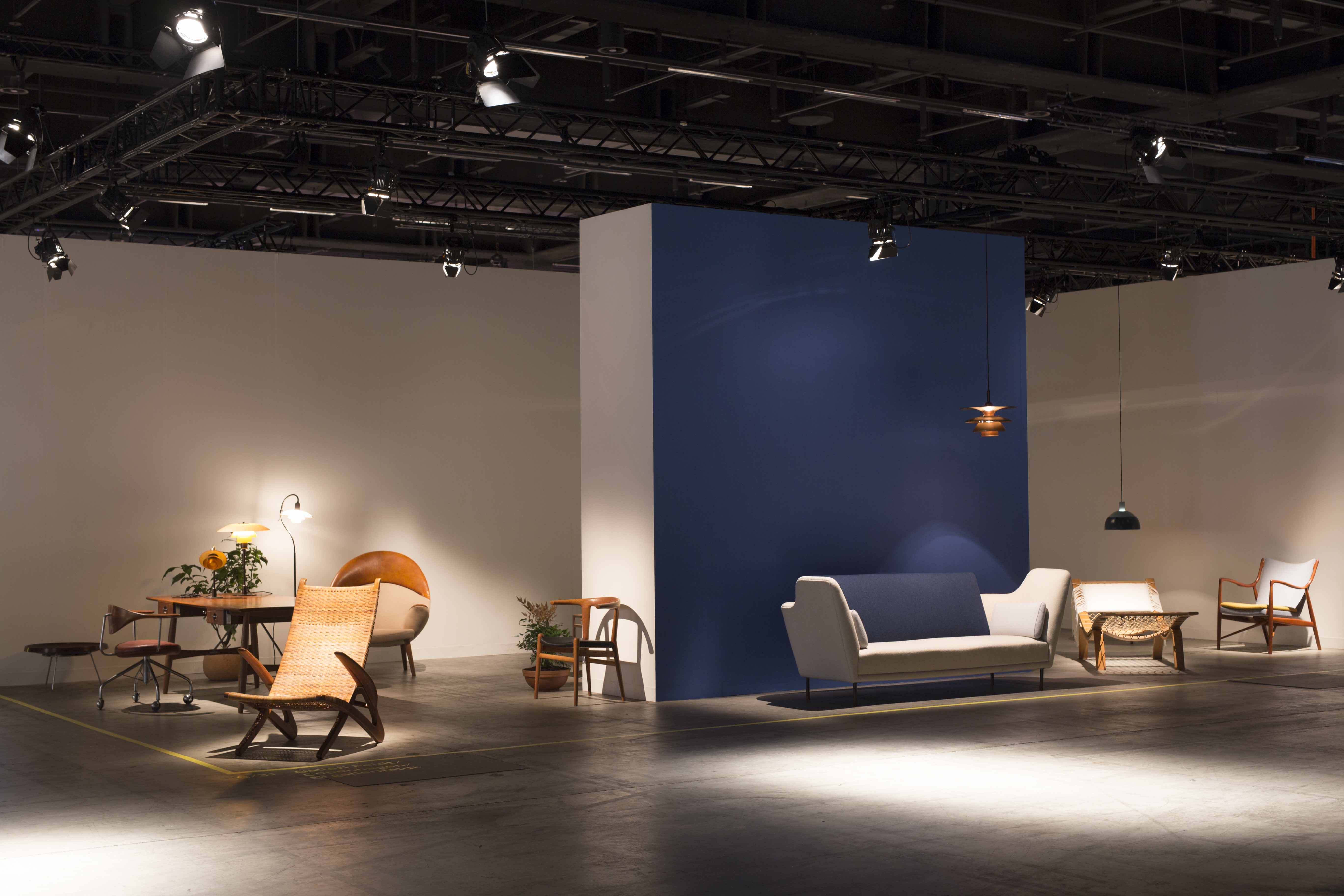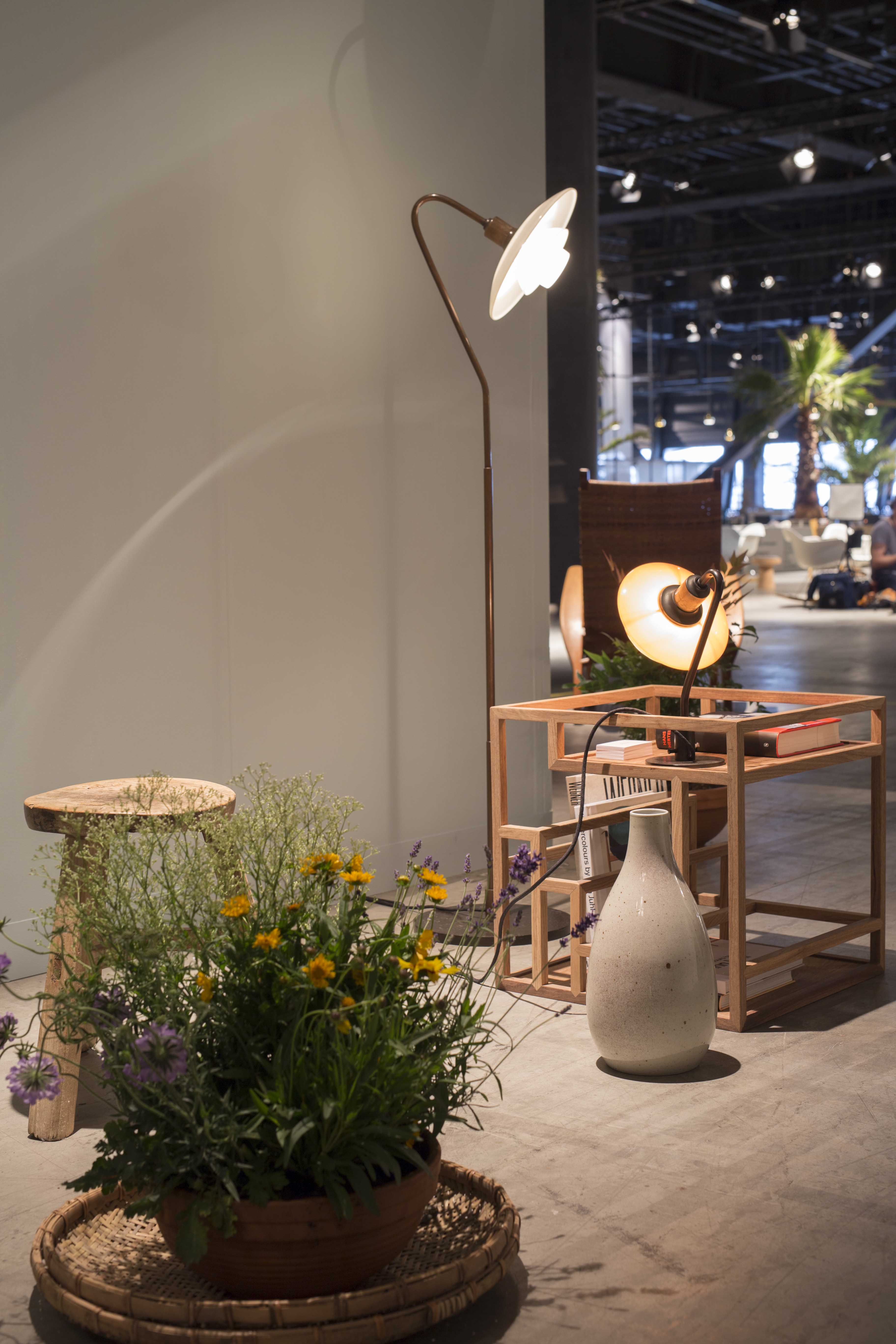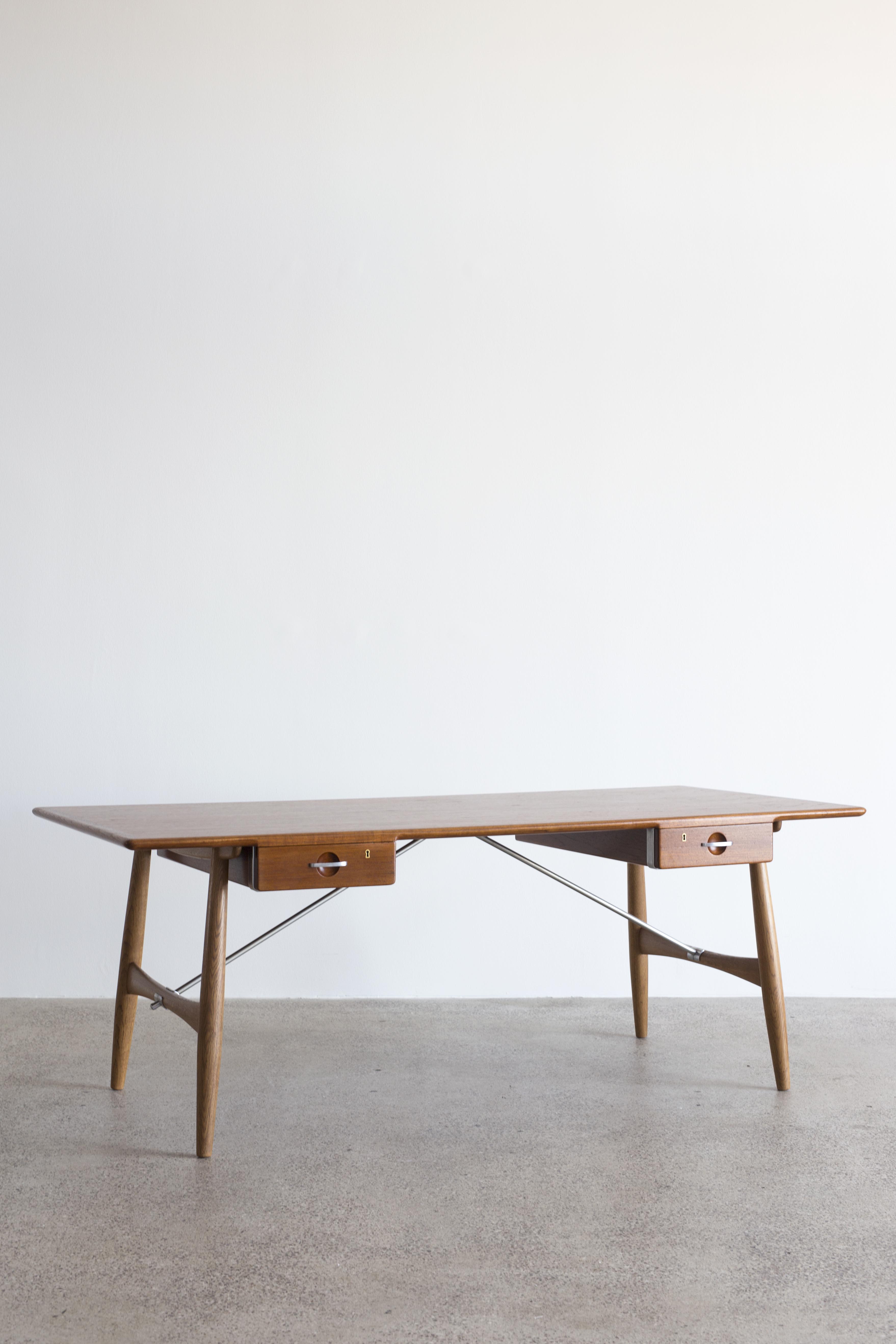
Galleri Feldt’s contribution to Design Miami/Basel 2018 showcases pieces by three of Danish Modern’s most influential designers—Hans J. Wegner (1914-2007), Finn Juhl (1912-1989), and Poul Henningsen (1894-1967). As essential ingredients in what we think of today as the Danish Modern aesthetic, their styles interact harmoniously with each other: both Wegner and Juhl famously practiced a sculptural mode of form-making the supple lines of which are well-served by the soft, diffuse light that PH endeavored to produce through his reflective multi-shade lamps. The collective warmth of a Wegner-Juhl-PH-clad interior, however, belies the vast and necessary differences in each of their approaches to the creative work of design, which can be respectively summed up as—although by no means reduced to—the practical, the abstract, and the scientific. Galleri Feldt’s installation draws attention to each designer’s distinct style and approach while bringing them together to present Danish Modern at its finest.
Wegner’s practicality was a matter of both character and training. He learned the craft of cabinetmaking at a young age, and had a keen sense for the materiality of wood. His ideas were often inspired by the structure of everyday tools, while his design process involved hands-on experimentation and the creation of a small model for each of his pieces before it was produced. He was also practical-minded when it came to the utility of his designs and the nature of the production process, in which he was deeply involved through his close collaboration with cabinetmaker Johannes Hansen (1886-1961). His vast imagination and exuberant inventiveness transmuted the concreteness of his methods into designs so artfully composed that their utility and their elegant naturalness appear to emanate from one another—hence the label “Organic Functionality” came to characterize the style he pioneered.
Although his furniture often share Wegner’s organic quality, Finn Juhl’s design process could not have been more different. With a prior interest in art history, Juhl had no practical experience in building furniture before he enrolled in the Architecture School at the Royal Academy in 1930. His designs, for which he was often inspired by abstract art like that of Henry Moore, Picasso, and Vilhelm Lundstrøm, would arise in his mind in their complete forms, without considerations of the possible structural and material constraints that they would encounter in practice. Indeed, his ideas were at times impossible to execute. The artistic expressiveness of Juhl’s pieces was at times too exuberant for contemporary critics—one of whom, for instance, likened his Pelikan chair (1940) to a “tired walrus”—and ruffled more feathers than Wegner’s harmonious designs ever did.


PH was a pioneer of the Danish Modern ethos of marrying beauty and functionality in design, and of making good design available on a widespread basis—an ethos which Wegner and Juhl operated under to varying degrees. He cannot, however, be compared to the two, since lighting design demanded a fundamentally different methodology than furniture design. Within his field, PH’s approach was pioneering in its scientific rigor: he was the first to use the logarithmic spiral (the same as a nautilus shell) as a basis for shade design, which allowed for an even distribution of light. With systematic study of the reflective qualities of different surfaces and shade shapes, he succeeded in creating a lamp that minimizes glare and allows for soft gradation from light to shadow. To PH, beauty emanated from a form’s rational fulfillment of its purpose. As he put it, “we most certainly don’t want new shapes, unless they are determined by new needs.”



The earliest and most famously sculptural piece of the exhibition is Wegner’s Dolphin Chair from 1950. It is constructed of an oak frame with brass fittings and handwoven cane, and features carved armrests that connect to it back legs and weep up in a narrow curve reminiscent of a diving dolphin’s silhouette. The form has inspired numerous other analogies, among them to an ocean-worn blade of an oar and a boomerang: the Dolphin’s ineffably organic quality invests it with a seeming referentiality to something shaped by natural necessity. In fact, it was shaped largely in response to practical considerations. It is a more comfortable version of Wegner’s Folding Chair (1949), an easy to stow away design meant to accommodate the cramped conditions of modern apartments. The addition of armrests to this existing design resulted in a lyrical composition in wood that, despite its beauty, was produced in only very few examples, rendering it currently extremely rare.

The Architect desk (1953) is an example of Wegner’s ability to draw on traditional forms in the creation of modern designs. Its slanted legs and metal struts are based on 17th century Spanish table form, which Wegner simplifies with tapering oak legs that lighten the teak tabletop and drawers. It is one of the first times that Wegner combined wood and steel in his designs, and the result is a mix of warmth and clarity; a transparent structure where all parts are both distinct and exquisitely connected.



The swivel chair (1955) is an office chair for the professional class that in itself embodies professional expertise. It is one of Wegner’s most carefully thought-through designs, for which he considered new developments in ergonomics in order to create a seat properly supportive of the lower back. The design’s scientific spirit is reflected in its structure, every centimeter of which was required specialized knowledge and skills to execute: the sumptuous teak top rail required a years-long drying process to get the wood at just the right humidity level; the stainless steel understructure demanded difficult hand-working and -polishing procedurse to achieve their soft, round forms. The swivel chair was also given a scientific aura in exhibitions (for one, the 1955 Cabinetmakers’ Exhibition), where it was displayed next to a diagram displaying the spine’s natural curvature and indicating the correct place for support, which the chair purportedly provides. Implicitly, the representation of the spine’s curvy structure forged an association between it and the organically swelling and tapering form of the chair’s top rail—a visual argument that the sculpted wood’s beauty stems from its responsiveness to nature’s forms.
The playfulness in the composition of materials and forms in the Upholstered Peacock chair makes it one of the most endearing of Wegner’s works. It takes its name and overall shape from Wegner’s own 1947 Peacock Chair (so named by Finn Juhl when he first saw the ), a veritable feat of woodworking on which Wegner worked especially closely with Johannes Hansen. Both designs are marked by a generosity and an openness as they beckon us to sit in them, but the contrast of colors and textures in the cloth and leather—a combination rarely seen elsewhere in Wegner’s oeuvre—lend the Upholstered Peacock a bold chic that its Windsor-inspired wooden forerunner doesn’t have.

The 45-chair is famous for having been the first armchair in which the upholstered areas were freed from the wooden frame, giving it a distinct lightness and elegance. Its structure allowed Finn Juhl to drive his characteristic pursuit of organic, flowing forms to its subtlest manifestation, particularly in the delicate tapering and swelling wood of the armrests. It is no surprise that since it was introduced at the 1945 Cabinetmaker’s Exhibition, it has become representative of Juhl’s inimitable style.

One of Finn Juhl’s most iconic designs, the Chieftain was so named for its throne-like character, and for the fact that Denmark’s King Frederick IX sat in it at the 1949 Cabinetmaker’s Guild Exhibition. Although it was well received at its unveiling, the unfamiliarity of the Chieftain’s form also elicited strange associations from its viewers—in one instance, it was likened to “pork chops that had been hung out to dry.” This underscores the radical nature of Juhl’s aesthetic approach, which was in this case not only inspired by abstract painting, but also by African weaponry. He created something hitherto unseen by insisting on pursuing his own vision, unencumbered by the then-prevailing strictures of Functionalism.




PH designed the four-shade lamp as a modern alternative to the conventional domestic chandeliers that were popular at time, but which he strongly disliked. The lamp’s topmost shade, added to his standard three-shade form, was designed to spread the amount of light that escapes upwards through the bottom shades and distribute it around the room. PH was particularly satisfied with this bronzed metal version of the lamp, which creates a clearly lit space below while casting a warm, diffuse light on the surrounding walls. The glass models were, however, more popular with the public, making this early bronze example a rarity.
The Tivoli Sofa was designed for the 1957 exhibition “Tidens Møbler” at Tivoli Gardens Concert Hall. Unusual in its large size and high armrests, which were designed to be comfortably leaned against in a casual lounging position, the sofa is one of Finn Juhl’s most unconventional designs. A contemporary ad titled “We live in a sofa!” tried to humorously cast the sofa’s oversized dimensions—out of proportion to the then typical Danish apartment—as something its owners would learn to grow into. It also appealed to the younger generation by suggesting that sitting no longer has to be done properly, but rather, playfully. Unfortunately, the Tivoli Sofa did not catch on, and very few examples of it were produced.

The Academy chandelier is PH’s first chandelier, designed in 1927 for the Royal Academy in Copenhagen. The three-shade principle on which PH based his entire lighting system is operative in the chandelier’s three spots, and it is designed to direct the majority of the light downward. The hand-blown opal glass shades with sandblasted undersides was an innovation that PH adapted only a year earlier (until then he used metal for his shades), and which allowed for a better light distribution, higher efficiency, and glare-free lighting. The Academy chandelier was popular in institutional and public settings like museums and railway stations, but was rarely seen in domestic settings. Very few early examples of it have survived.
